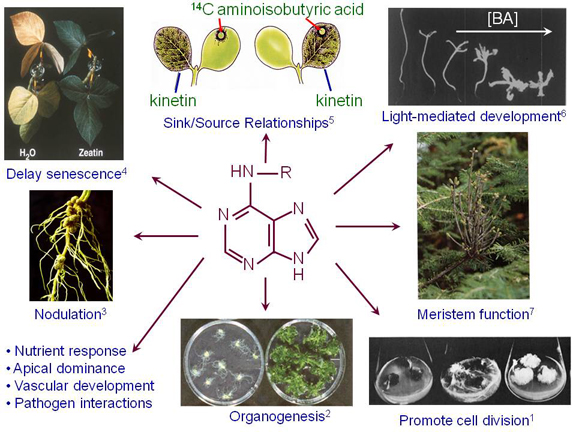
Cytokinin Signaling
Cytokinins are N6-substituted adenine derivatives that have profound developmental effects on plants. They were first identified by their ability to stimulate, in concert with the plant hormone auxin, cell division in cultured plant cells (see: History of cytokinin). Cytokinins have since been shown to play a role in diverse aspects of plant growth and development, including cell division, shoot initiation and growth, senescence, chloroplast development, nutrient uptake, sink/source relationships, nodulation in legumes, vascular development and photomorphogenic development.

Figure 1: Illustration of some the functions of cytokinins in plant growth and development.
References: 1) Skoog, F. and Miller, C.O. (1957) Chemical regulation of growth and organ formation in plant tissue cultured in vitro. Symp Soc Exp Biol XI: 118–131; 2) Kakimoto T. (1996) CKI1, a histidine kinase homolog implicated in cytokinin signal transduction. Science 274:982-5; 3) Tirichine, L., Sandal, N., Madsen, L.H., Radutoiu, S., Albrektsen, A.S., Sato, S., Asamizu, E., Tabata, S. and Stougaard, J. (2007) A gain-of-function mutation in a cytokinin receptor triggers spontaneous root nodule organogenesis. Science 315 : 104–107 & Murray, J.D., Karas, B.J., Sato, S., Tabata, S., Amyot, L. and Szczyglowski, K. (2007) A cytokinin perception mutant colonized by Rhizobium in the absence of nodule organogenesis. Science 315: 101–104. 4) 5) Plant Physiology, 4th edition, Taiz and Zeiger, eds.; 6) Chory, J., Reinecke, D, Sim, S, Washburn, T., Brenner, M. (1994) A role for cytokinins in de-etiolation in Arabidopsis. Plant Physiol. 104:339-347. 7) Plant Physiology, 4th edition, Taiz and Zeiger, eds.
Recent molecular genetic studies in Arabidopsis have uncovered a cytokinin signaling pathway that is similar to bacterial and yeast two-component signal transduction pathways (See: Two-component signaling), specifically to His-Asp multi-step phosphorelays, which are comprised of hybrid sensor kinases, histidine phosphotransfer proteins (Hpts) and response regulators (Fig. 2).

Figure 2: Diagram of a simple two-component system compared to a phosphorelay. Histidine kinase domains are indicated by rectangles, receiver domains by ovals, HPt proteins by rounded rectangles, and transmembrane domains by black bars. Sites of phosphorylation upon histidine (H) and aspartic acid (D) residues are indicated.
There are three Arabidopsis cytokinin Arabidopsis Histidine Kinase (AHK) receptors, which contain a conserved extra-cellular cytokinin binding CHASE domain, a histidine kinase domain and a receiver domain. The downstream targets of the AHK cytokinin receptors are the five Arabidopsis homologs of HPt proteins (AHPs). Analysis of gain- and loss-of-function alleles indicate that the AHPs are positive, redundant elements in the cytokinin primary signal transduction pathway. The ARRs are the downstream targets of the AHPs. The Arabidopsis genome contains 23 ARR genes that fall into two main groups based on their sequence similarities, domain structure and transcriptional response to cytokinin. The type-A ARRs are comprised of a receiver domain and a short C-terminus and their transcription is rapidly elevated in response to cytokinin. The type-B ARRs, in addition to the receiver domain, have a C-terminal output domain that includes a DNA-binding GARP domain and a transcriptional activation domain. Transcription of the type-B ARRs is not altered by cytokinin. The type-A ARRs are highly redundant, negative regulators of cytokinin signaling. The transcriptional induction of the type-A ARRs by cytokinin is mediated by the type-B ARRs, which are redundant, positive elements in cytokinin signaling. The different type-B ARRs likely mediate the induction of distinct, but overlapping sets of cytokinin-regulated genes.

Figure 3: Model for cytokinin signaling. Cytokinin binding to the AHK cytokinin receptors results in autophosphorylation on a His residue. The phosphoryl group is then transferred to an Asp on the fused receiver domain (red) and then is shuttled to the receiver domain of the type-A and type-B ARRs (red) via an AHP intermediate (green). The phosphorylated, and thus activated, type-B ARRs in turn regulate the transcription of numerous genes, including the type-A ARRs. The type-A ARRs negatively regulate the pathway via an unknown mechanism. The CRFs act in parallel with the type-B ARRs to modulate cytokinin-regulated transcription.